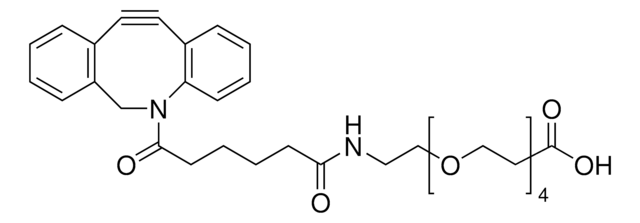744867
(1R,8S,9s)-Bicyclo[6.1.0]non-4-in-9-ylmethyl]-N-succinimidylcarbonat
for Copper-free Click Chemistry
Synonym(e):
N-[((1R,8S,9s)-Bicyclo[6.1.0]non-4-in-9-yl)-methyloxycarbonyloxy]-succinimid, BCN-NHS, BCN-succinimidylester
About This Item
Empfohlene Produkte
Form
powder
Zusammensetzung
carbon content, 61.85%
hydrogen content, 5.88%
nitrogen content, 4.81%
Eignung der Reaktion
reaction type: click chemistry
reagent type: cross-linking reagent
Funktionelle Gruppe
NHS ester
Lagertemp.
−20°C
SMILES String
[H][C@@]12CCC#CCC[C@]1([H])[C@@H]2COC(ON3C(CCC3=O)=O)=O
InChI
1S/C15H17NO5/c17-13-7-8-14(18)16(13)21-15(19)20-9-12-10-5-3-1-2-4-6-11(10)12/h10-12H,3-9H2/t10-,11+,12-
InChIKey
SKTDJYHCSCYLQU-ZSBIGDGJSA-N
Anwendung
It may also be used to synthesize bicyclononyne functionalized poly(ethylene glycol) polymer coatings with anti-fouling properties towards protein adhesion and cell adhesion for supramolecular ureidopyrimidinone (UPy) based materials.
Verpackung
Lagerklassenschlüssel
11 - Combustible Solids
WGK
WGK 3
Flammpunkt (°F)
Not applicable
Flammpunkt (°C)
Not applicable
Analysenzertifikate (COA)
Suchen Sie nach Analysenzertifikate (COA), indem Sie die Lot-/Chargennummer des Produkts eingeben. Lot- und Chargennummern sind auf dem Produktetikett hinter den Wörtern ‘Lot’ oder ‘Batch’ (Lot oder Charge) zu finden.
Besitzen Sie dieses Produkt bereits?
In der Dokumentenbibliothek finden Sie die Dokumentation zu den Produkten, die Sie kürzlich erworben haben.
Kunden haben sich ebenfalls angesehen
Artikel
Copper-free click chemistry is an alternative approach to click chemistry that proceeds at a lower activation barrier and is free of cytotoxic transition metal catalysts.
Drug discovery process by utilizing chemistry reaction of Cu(I)-catalyzed Huisgen 1,3-dipolar cycloaddition of terminal alkynes with organoazides to yield 1,4-disubstituted 1,2,3-triazoles.
Unser Team von Wissenschaftlern verfügt über Erfahrung in allen Forschungsbereichen einschließlich Life Science, Materialwissenschaften, chemischer Synthese, Chromatographie, Analytik und vielen mehr..
Setzen Sie sich mit dem technischen Dienst in Verbindung.
![(1R,8S,9s)-Bicyclo[6.1.0]non-4-in-9-yl-methanol for Copper-free Click Chemistry](/deepweb/assets/sigmaaldrich/product/structures/171/632/0556139a-2db5-4678-a6ec-a26a693fd574/640/0556139a-2db5-4678-a6ec-a26a693fd574.png)

![N-[(1R,8S,9s)-Bicyclo[6.1.0]non-4-in-9-ylmethyloxycarbonyl]-1,8-diamino-3,6-dioxaoctan for Copper-free Click Chemistry](/deepweb/assets/sigmaaldrich/product/structures/294/853/c5e47d84-5aee-4797-aa24-604f291171cc/640/c5e47d84-5aee-4797-aa24-604f291171cc.png)






